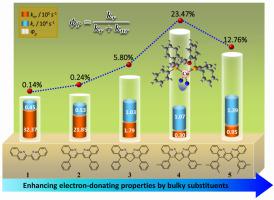Organic Electronics ( IF 2.7 ) Pub Date : 2021-05-18 , DOI: 10.1016/j.orgel.2021.106185 Yuan-Nan Chen , Teng-Fei He , Yan-Xiang Cheng , Hong-Mei Zhan , Ai-Min Ren , Tong-Shun Wu , Bo-Hua Zhang , Yun-Li Zhang , Hong-Xing Zhang , Lu-Yi Zou

|
Various tetrahedral heteroleptic Cu(I) complexes, as red organic light-emitting diodes (OLEDs), show a concern of maximizing the quantum yield (QY) in order to improve the optoelectronic performance. Herein, three experimental [Cu(N^N) (bis [2-(diphenylphosphino)phenyl]ether)]+ (named 1, 2 and 3) were selected as the jumping-off point, following two complexes (named 4 and 5) were successfully designed by introducing bulky electron-donating substituents into N^N ligands continuously. As expected, the QY of designed complexes 4 (0.26) and 5 (0.13) exhibit over twice higher than that of 3 (5.4 × 10−2). This can be attributed to the enhanced electron-donating property of N^N ligand, which accelerated the radiative transition rate (kr) through the apparently elevated energy level of the lowest triplet excited state (T1) and strengthened transition dipole moments, even though the spin-orbit coupling (SOC) effect is weakened. Simultaneously, the tetrahedral geometric distortion could be effectively restrained by the bulky N^N ligands, but the high vibrational freedom of the terminal substituents could also bring in some unfavorable intra-ligand deformation, resulting in an upward of the nonradiative transition rate (knr) at 5 (knr: 0.30 × 105 s−1 for 4; 0.95 × 105 s−1 for 5). Therefore, it's worth noting that the balance of excited state energy level, SOC effect as well as the reorganization energy ought to be elaborately regulated to achieve the optimal QY. This detailed investigation on the microscopic mechanism of these Cu(I) complexes can provide instructive inspiration for experimentalists.
中文翻译:

DPEphos喹啉取代衍生物用于OLED提高磷光效率的理论设计研究
各种四面体杂配Cu(I)配合物,作为红色有机发光二极管(OLED),表现出最大化量子产率(QY)以提高光电性能的担忧。在此,三个实验性的 [Cu(N^N) (双 [2-(二苯基膦基)苯基]醚)] + (命名为1、2和3 ) 被选为起点,继两个配合物 (命名为4和5 ) 是通过将庞大的给电子取代基连续引入 N^N 配体而成功设计的。正如预期的那样,设计的配合物4 (0.26) 和5 (0.13)的 QY比3 (5.4 × 10-2 )。这可以归因于 N^N 配体增强的给电子特性,通过最低三重激发态 (T 1 )的明显升高的能级和增强的跃迁偶极矩,加速了辐射跃迁速率 ( k r ) ,甚至尽管自旋轨道耦合(SOC)效应减弱。同时,庞大的N^N配体可以有效地抑制四面体几何变形,但末端取代基的高振动自由度也会带来一些不利的配体内变形,导致非辐射跃迁率(k nr ) 在5 ( k nr : 0.30 × 105 s -1为4;0.95 × 10 5 s -1为5 )。因此,值得注意的是,激发态能级、SOC效应以及重组能的平衡需要精心调节,以达到最佳的QY。对这些 Cu(I) 配合物微观机理的详细研究可以为实验者提供有益的启发。











































 京公网安备 11010802027423号
京公网安备 11010802027423号